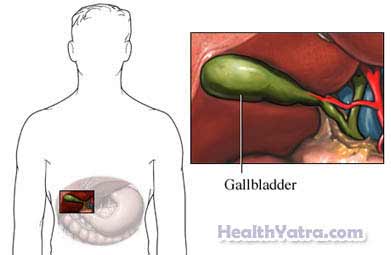Definition
Gallbladder cancer is a disease in which cancer cells grow in the gallbladder. This is a relatively rare form of cancer. The gallbladder is a small pear-shaped organ. It sits beneath the liver and stores bile until it is needed by the digestive system. Bile is a greenish-yellow digestive fluid produced by the liver that helps in digesting fat.
Cancer occurs when cells in the body (in this case gallbladder cells) divide without control or order. Normally, cells divide in a regulated manner. If cells keep dividing uncontrollably when new cells are not needed, a mass of tissue forms, called a growth or tumor. The term cancer refers to malignant tumors, which can invade nearby tissue and spread to other parts of the body. A benign tumor does not invade nor spread.

Causes
The exact cause of gallbladder cancer is unknown.
Risk Factors
A risk factor is something that increases your chance of getting a disease or condition. Risk factors include:
- Sex: female
- Having gallstones or chronic inflammation of the gallbladder, including calcification of the gallbladder (porcelain gallbladder)
- Ethnicity: Native American and Hispanics have a higher incidence of gallbladder cancer, perhaps because they also have a higher incidence of gallstones.
- Typhoid fever or chronic salmonella infection
- Physical abnormalities of the gallbladder and ducts, such as choledochal cysts or polyps of the gallbladder
- Exposure to some chemicals, such as azotoluene and nitrosamines, found in metal processing and rubber production
Women are more likely to get gallbladder cancer than men are. It is also more common in older individuals.
Symptoms
Gallbladder cancer often shows no symptoms in its early stages. As the disease progresses, symptoms associated with bile obstruction often develop. These include:
- Abdominal pain
- Pain in the upper back (called referred pain)
- Jaundice (yellowing of the “whites” of the eyes, the skin, under the tongue)
Other symptoms may include:
- Nausea and/or vomiting
- Loss of appetite
- Weight loss
- Liver and spleen enlargement
- Increased abdominal girth
Diagnosis
Gallbladder cancer is often hard to diagnose because:
- The disease often shows no early symptoms.
- The symptoms often mimic those of other gallbladder conditions (such as gallstones).
- Other organs in the abdomen hide the gallbladder.
Gallbladder cancer is sometimes discovered during abdominal surgery for another reason.
The doctor will ask about your symptoms and medical history, and perform a physical exam. Tests may include:
- Blood tests—testing to check levels of bilirubin (part of the bile) and liver enzymes
- Ultrasound —a test that uses sound waves to examine internal organs, in this case, the gallbladder and bile ducts. The radiologist will examine the gallbladder with the ultrasound probe and may see stones inside; stones often can mask the presence of cancer.
- CT scan —a type of x-ray that uses a computer to make pictures of the inside of the body, in this case, the liver, gallbladder, bile ducts, and surrounding tissue. The CT scan can help determine if the gallbladder is calcified or surrounded by a lining of calcium. This condition is called a porcelain gallbladder and can be caused by the growth of cancer cells. The CT scan is also helpful to determine if the cancer has spread to the lymph nodes or liver (the two most common places for gallbladder cancer to spread).
- Cholangiography—an invasive test that uses x-rays and a large needle inserted into the liver to examine the gallbladder and bile ducts. This can be done to collect cells from the bile ducts to help diagnosis cancer.
- Endoscopic retrograde cholangiopancreatography (ERCP)—a test that combines x-rays and an endoscope, which is a long, flexible, lighted tube inserted down the throat. This is done to examine the duodenum (first part of the small intestine), bile ducts, and pancreatic ducts. It can also be used to collect cells to help diagnose cancer.
- MRI scan —a test that uses magnetic waves to make pictures of structures inside the body
A biopsy, which is the removal of a sample of tissue for testing, must be done to definitively diagnose gallbladder cancer. This often requires open surgery. Many times gallbladder cancer is found by accident. The patient is often taken to surgery because of a gallbladder “attack.” At surgery, the surgeon may find cancer or it may only be found once the pathologist has sliced the entire gallbladder into very small slices.
Treatment
Once gallbladder cancer is found, staging tests are performed to find out if the cancer has spread and, if so, to what extent. Treatment depends on the stage of the cancer. For advanced cancers, treatment is done only to help relieve symptoms. Treatments include:
Surgery
Surgical removal of the gallbladder is called cholecystectomy. Part of the liver and lymph nodes near the gallbladder may also be removed. In some cases, surgery is done to relieve symptoms by opening obstructed bile ducts. ERCP may also be used for this purpose.
Radiation Therapy
Radiation therapy uses radiation to kill cancer cells and shrink tumors. Radiation is most often administered from a source outside the body.
Chemotherapy
Chemotherapy is the use of drugs to kill cancer cells. The drugs enter the bloodstream and travel through the body killing mostly cancer cells, but also some healthy cells. Chemotherapy is not considered curative for gallbladder cancer, but may relieve symptoms in some patients.
Combined Modality Therapy (CMT)
CMT is a term gaining popularity and meaning several treatments at once or in succession. Although no one has shown that chemotherapy and radiation therapy at the same time are better than radiation therapy alone in the treatment of gallbladder cancer, CMT is better with many other kinds of cancers.
Prevention
There are no guidelines for preventing gallbladder cancer because the cause is usually not known. There may be an association with gallstones. Because gallbladder cancer is rare, doctors do not recommend the routine removal of gallbladders in people with asymptomatic gallstones to prevent cancer.
